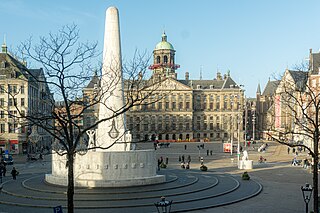
Dam Square or the Dam is a town square in Amsterdam, the capital and most populated city of the Netherlands. Its notable buildings and frequent events make it one of the best-known and most important locations in the city and the country.
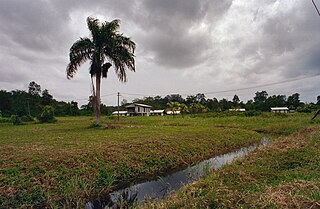
Commewijne is a district of Suriname, located on the right bank of the Suriname River. Commewijne's capital city is Nieuw Amsterdam. Tamanredjo is another major town, while Meerzorg is the most populated.

The Amstel is a river in the province of North Holland in the Netherlands. It flows from the Aarkanaal and Drecht in Nieuwveen northwards, passing Uithoorn, Amstelveen, and Ouderkerk aan de Amstel, to the IJ in Amsterdam, to which the river gives its name. Annually, the river is the location of the Liberation Day concert, Head of the River Amstel rowing match, and the Amsterdam Gay Pride boat parade.
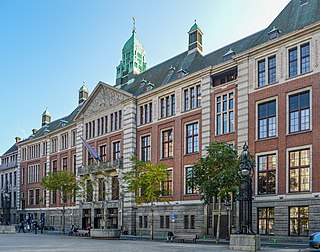
Euronext Amsterdam is a stock exchange based in Amsterdam, the Netherlands. Formerly known as the Amsterdam Stock Exchange, it merged on 22 September 2000 with the Brussels Stock Exchange and the Paris Stock Exchange to form Euronext. The registered office of Euronext, itself incorporated in the Netherlands a public limited company, is also located in the exchange.
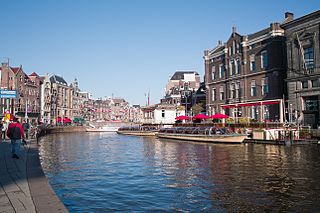
The Rokin is a canal and major street in the centre of Amsterdam. The street runs from Muntplein square to Dam square. The Rokin canal used to run from Muntplein square to Dam Square, but in 1936, the part between Spui square and Dam Square was filled in. Canal boats are now moored on the remaining part of the water, from the Amstel to Grimburgwal.

Amsterdam, capital of the Netherlands, has more than 100 kilometers (62 mi) of grachten (canals), about 90 islands and 1,500 bridges. The three main canals, dug in the 17th century during the Dutch Golden Age, form concentric belts around the city, known as the Grachtengordel. Alongside the main canals are 1550 monumental buildings. The 17th-century canal ring area, including the Prinsengracht, Keizersgracht, Herengracht and Jordaan, were listed as UNESCO World Heritage Site in 2010, contributing to Amsterdam's fame as the "Venice of the North".

The Alteratie is the name given to the change of power in Amsterdam on May 26, 1578, when the Catholic city government was deposed in favor of a Protestant one. The coup should be seen in the context of the greater Dutch Revolt that was breaking out in this time. Trade interests played an important role, because Amsterdam was becoming isolated as surrounding cities and towns joined the revolt, and other cities were threatening to take over its trade. No one was injured or killed during the coup. On May 29, a new city council was formed, consisting of 30 Calvinists and 10 Catholics. Already after a few months, plans were presented to expand the city and the harbor on the eastern side (Lastage), and to construct new defensive fortifications.
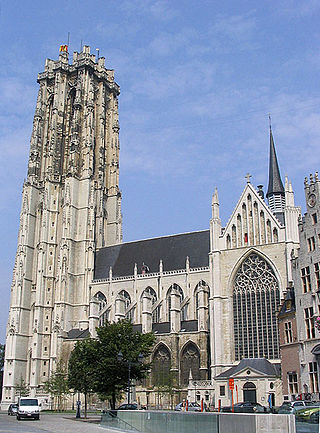
Brabantine Gothic, occasionally called Brabantian Gothic, is a significant variant of Gothic architecture that is typical for the Low Countries. It surfaced in the first half of the 14th century at St. Rumbold's Cathedral in the city of Mechelen.

The Makelaers Comptoir or Makelaarskantoor, the "brokers' office", is a 17th-century guildhall in Amsterdam, at the corner of Nieuwezijds Voorburgwal and the alley Nieuwe Nieuwstraat. It is one of the few remaining guildhalls in Amsterdam.
Praetorium Agrippinae was a Roman settlement in the province of Lower Germania, in the area of the Cananefates, located in modern-day Valkenburg, Netherlands. It was an army encampment on the Old Rhine, on the northern border of the Roman Empire, the limes. Praetorium Agrippinae is mentioned on the Tabula Peutingeriana between the castella of Matilo in the east and Lugdunum Batavorum to the west.

The Walloon Church is a Protestant church building in Amsterdam, along the southern stretch of the Oudezijds Achterburgwal canal. The building dates to the late 15th century and has been in use as a Walloon church since 1586. The church was also known as the Franse Kerk, Walenkerk, Oude Walenkerk, or Oude Waalse Kerk.

The Korenbeurs is a neoclassical building in Groningen in the Netherlands. It was originally used as an exchange for food grain trade. Its current tenant is Albert Heijn.
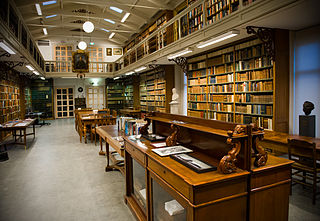
Artis Bibliotheek is a nineteenth-century library located at Plantage Middenlaan 45 in Amsterdam. Since 2005, the Artis Bibliotheek has been part of the Special Collections at the University of Amsterdam.

Constant Cornelis Huijsmans was a Dutch art teacher and painter, whose roots go back to the seventeenth-century Antwerp of the landscape painter Cornelis Huysmans (1648–1727). Paintings of the latter are to be found at the Louvre in Paris and at the Hermitage Museum in Saint Petersburg, Russia. Earlier generations of the Huijsmans family used to spell their family name slightly differently, as Huysmans.
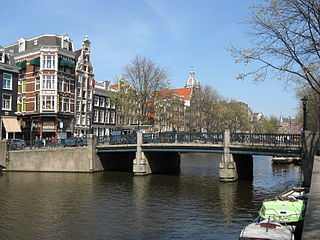
The Geldersekade is a canal and a street in Amsterdam that connects the Nieuwmarkt with the Prins Hendrikkade. The Geldersekade is in the easternmost part of De Wallen, the red light district, and borders Chinatown.

The Vijzelgracht is a street and former canal in Amsterdam. The Vijzelgracht is adjacent to the Grachtengordel and is an extension of one of the most important city radii for public transport and normal traffic. This through route leads via Vijzelstraat, Rokin, Dam Square and Damrak to Central Station. To the south of Vijzelgracht, the Nieuwe Vijzelstraat connects to Weteringschans.

The Tabakspanden are a group of buildings standing on the Spuistraat in central Amsterdam, adjacent to the Keizerrijk and Wijdesteeg alleyways. Named after a former owner, the speculator Hendrik Tabak, they were mostly squatted from 1983 onwards, although the artist Peter Klashorst also rented an apartment and gallery space. The best known building was Spuistraat 199, known as the Slangenpand (Snakehouse) because of the large mural which covered the front exterior. In 2015, the squatters were evicted and the buildings were mostly demolished prior to redevelopment. The new project is known as De Keizer and has 69 apartments, a restaurant and a gallery. Two of the buildings are registered as rijksmonumenten.

Prins Hendrikkade is a major street in the centre of Amsterdam. It passes Amsterdam Central Station, intersects the Damrak at the mouth of the Amstel river, and forms the southern end of the IJtunnel across the IJ bay. The street formed the northern edge and outer harbour of the city until the 19th century. It was named after Prince Henry of the Netherlands, youngest son of King William II, following Henry's death in 1879.
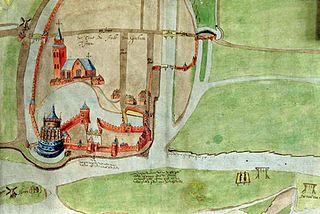
The Blue Tower was a castle with an imposing stone keep in Gorinchem, the Netherlands. It was a princely residence of Charles the Bold, Duke of Burgundy. The complex, which stood there between 1461 and 1578, gained an almost mythical status thanks in part to descriptions by the Gorinchem chronicler Abraham Kemp and the discovery of its foundations in 1983.



















